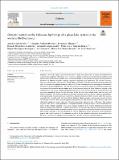Por favor, use este identificador para citar o enlazar a este item:
http://hdl.handle.net/10261/334279COMPARTIR / EXPORTAR:
 SHARE SHARE
 CORE
BASE CORE
BASE
|
|
| Visualizar otros formatos: MARC | Dublin Core | RDF | ORE | MODS | METS | DIDL | DATACITE | |

| Título: | Climatic control on the Holocene hydrology of a playa-lake system in the western Mediterranean |
Autor: | García-Alix, Antonio CSIC ORCID; Jiménez-Moreno, Gonzalo; Gázquez, Fernando; Monedero-Contreras, Ricardo; López-Avilés, Alejandro; Jiménez-Espejo, Francisco J.; Rodríguez-Rodríguez, Miguel; Camuera, Jon; Ramos-Román, María J.; Scott Anderson, R. | Palabras clave: | Paleohydrological evolution Southwestern Iberian Peninsula Saline lakes Aridification |
Fecha de publicación: | jul-2022 | Editor: | Elsevier BV | Citación: | Catena 214 (2022) | Resumen: | Evaporitic lakes such as playa-lakes are characteristic of many arid regions and are unique environments with respect to fauna and flora, while being very vulnerable to climate and environmental fluctuations and threatened by the current global change scenario. Water balance oscillations in these systems can trigger the precipitation or dissolution of different evaporitic minerals, negatively impacting local biodiversity and economic activities. Here, we study the sedimentary record of a small saline pond from a playa-lake complex in southwestern Iberia in order to reconstruct the paleohydrological evolution of this area and assess potential anthropogenic disturbances. The different proxies studied in the ∼11.9 ky old sedimentary record of the Laguna de la Ballestera suggest that the greatest lake extension and the highest water levels occurred during the Early Holocene, pointing to the wettest period of the record. Climate transitioned towards more arid conditions during the Middle Holocene, and even more dramatically during the Late Holocene. In this last stage the wetland surface and the water level largely diminished and gypsum precipitation gradually increased pointing towards a negative precipitation/evapotranspiration balance and lowest water levels. Summer desiccation likely occurred under this scenario, especially after ∼1.0–0.9 cal ky BP coeval with the Medieval Climate Anomaly, when gypsum content started to rise abruptly. However, this significant gypsum precipitation was only associated with a massive drop in the siliciclastic content and scarce carbonates (dolomite and calcite) during the last ∼400 years. This evidence suggests a shift from a (semi) permanent to a temporal/seasonal hydrological regime. The environmental evolution of this wetland responded to the general climatic evolution of the western Mediterranean during the Holocene, being mostly controlled by changes in insolation. Our data also show that the environmental response of the studied wetland to natural climate variations was only significantly disturbed by human activities since the 20 century, especially in the second half of the century, deduced by abrupt fluctuations in the siliciclastic, gypsum and organic content in the sediments, as well as by the enhanced sedimentary accumulation rates, probably as a response to changes in the hydroperiod of the lake and in the catchment land use. | Versión del editor: | http://dx.doi.org/10.1016/j.catena.2022.106292 | URI: | http://hdl.handle.net/10261/334279 | DOI: | 10.1016/j.catena.2022.106292 | Identificadores: | doi: 10.1016/j.catena.2022.106292 issn: 0341-8162 |
| Aparece en las colecciones: | (IACT) Artículos |
Ficheros en este ítem:
| Fichero | Descripción | Tamaño | Formato | |
|---|---|---|---|---|
| JimenezEspejo_Catena_2022.pdf | 12,86 MB | Adobe PDF |  Visualizar/Abrir |
CORE Recommender
SCOPUSTM
Citations
3
checked on 20-abr-2024
WEB OF SCIENCETM
Citations
2
checked on 23-feb-2024
Page view(s)
23
checked on 27-abr-2024
Download(s)
7
checked on 27-abr-2024
Google ScholarTM
Check
Altmetric
Altmetric
Este item está licenciado bajo una Licencia Creative Commons

